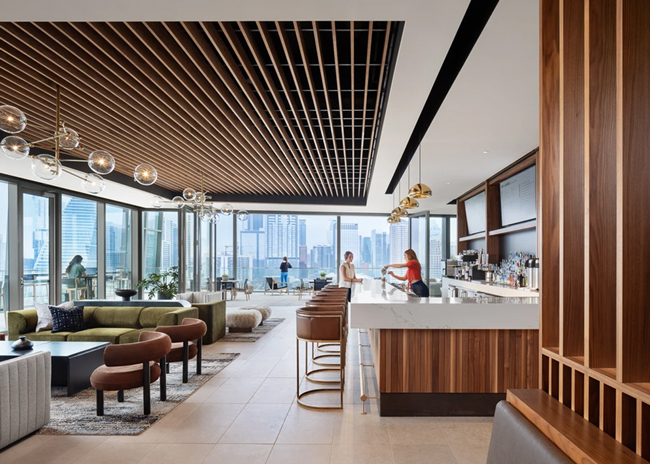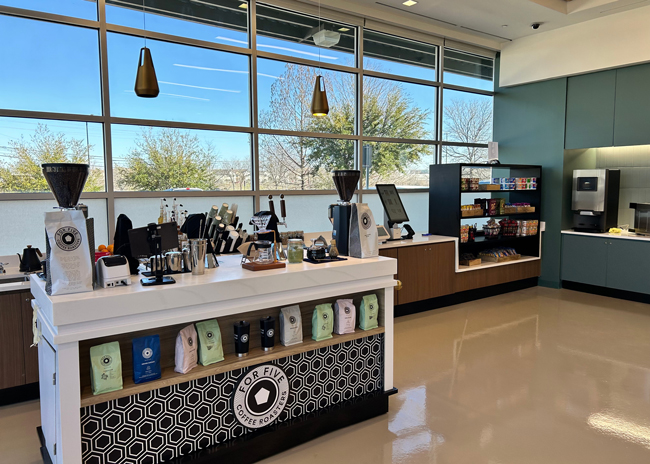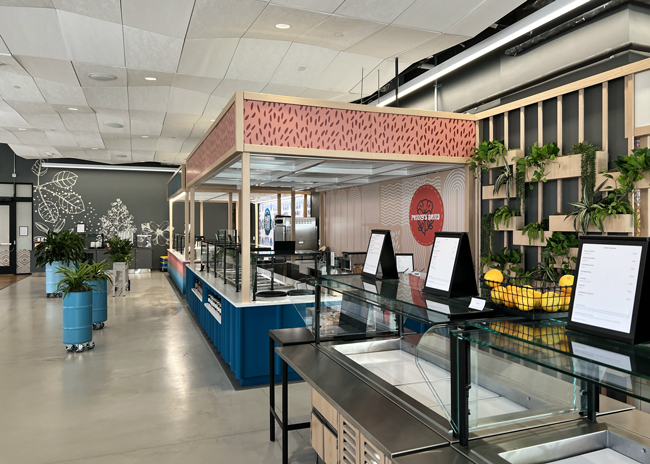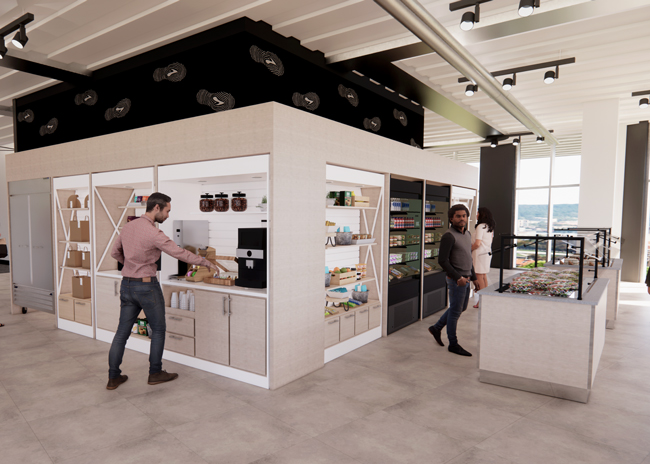Corporate dining remains a hub of activity, as companies, building owners and managers struggle to accommodate workers’ hybrid schedules, fluctuating numbers in the office from day to day, evolving consumer preferences and new operational challenges.
Foodservice designers continue to turn to a variety of tools in their toolboxes to meet these challenges, from quick, cosmetic refreshes of problematic foodservice sites to major new-build projects that represent a complete rethinking of prior assumptions. What’s being offered to employees nowadays can range from traditional breakfast-and-lunch rooms to quick-change pods to retail micromarkets.
 At Guckenheimer’s B&I accounts, a colorful Chickpea Spaghetti Carbonara dish includes mushroom pancetta, rainbow cauliflower, vegan parmesan and herb oil; it’s served with a grilled baguette. Photo courtesy of Guckenheimer“This year, after a few years of not working on many corporate dining projects, we had an explosion of work,” says Eric Goodrich, FCSI, principal at Minnesota-based Rippe Associates. “The majority of our work is renovating older spaces as part of amenities upgrades that may also include gyms, game rooms, lounges and outdoor spaces.”
At Guckenheimer’s B&I accounts, a colorful Chickpea Spaghetti Carbonara dish includes mushroom pancetta, rainbow cauliflower, vegan parmesan and herb oil; it’s served with a grilled baguette. Photo courtesy of Guckenheimer“This year, after a few years of not working on many corporate dining projects, we had an explosion of work,” says Eric Goodrich, FCSI, principal at Minnesota-based Rippe Associates. “The majority of our work is renovating older spaces as part of amenities upgrades that may also include gyms, game rooms, lounges and outdoor spaces.”
Goodrich notes that building managers and individual companies face the same problem they’ve dealt with since 2021 — workers are unenthusiastic about returning to the office. What’s different now, though, is the fact that they’re making significant investments in what they believe will be long-term solutions. Landlords and company executives are “trying to improve employee engagement,” he says. “There’s everything from lawn bowling and bocce ball to outdoor bars; it’s getting pretty extravagant.” As part of these efforts, employers and building management are “much more willing to spend on modernizing dining facilities that, in downtown districts, may not have been touched in 40 years.”
Melissa Counihan, FCSI, chief operating officer of Texas-based Counihan and Associates, sees similar developments in the business and industry (B&I) segment. “Our corporate and business-oriented clients are trying to up their game with amenities for employees to make sure they stay happy and stay there,” she says.
Kristin Sedej, FCSI, principal and owner of Illinois- and Florida-based S2O Consultants, has been working on an all-remote foodservice concept for a company’s new-build headquarters. In this case, remote doesn’t mean the employees will work from home; they’ll be in the building, she explains, but will place their food orders via phone, computer or a kiosk, and then collect orders at a pickup area. Diners may return to their desks or another spot to eat or take advantage of “tons of seating in a beautiful dining room,” Sedej says.
Indeed, this is but one example of the way corporate foodservice is being rethought. “Tastes have changed,” says Garin Wong, vice president of consulting services at New York-based elite | studio e. This includes “the way people get food, the ordering experience, the way they pick up the order [and] where they eat.”
Navigating the Ups and Downs of Daily Traffic
Hybrid schedules have become a fixture in offices around the country, where many — if not most — employees choose to work from home on Mondays and Fridays, with higher (but still variable) in-office employee counts on Tuesdays, Wednesdays and Thursdays.
“The actual layout of the equipment and the selection of stations has changed because with hybrid work schedules, a servery doesn’t run at 100% capacity every day of the week,” Wong says. “You don’t want to have six stations shut down on some days, and you don’t want to pay somebody standing by a station on Friday if nobody comes. So, the company cafe may now have more of a fast-casual restaurant feel, with all food orders picked up at one counter. The chef may do more specials on Fridays, knowing that it’s the end of the week. There may be more pickup spaces and cubbies, so someone who has pre-ordered a meal can come in the door and pick it up and turn right back around. Employees may order from a website, a phone app or a kiosk, instead of placing their order with someone in the dining room.”
Flexible food stations or a food court setup represent creative solutions to the challenges corporate feeders face. “We have some B&I projects where the client wanted a centralized pickup place among a few concepts, but for the most part, diners prefer to pick up their food at the concept’s counter,” says Goodrich. “If they want something off the grill, they’d rather go to the grill area to pick it up. But they aren’t ordering their food there. Almost everyone today preorders — by phone or at a kiosk outside the food hall — and either prepays or pays at a self-service, unstaffed POS station on the way out.”
Seating arrangements are equally important to rethink, says Counihan. “Interior design packages look very different than they ever did before,” she says. “Varied seating, less formal seating — fewer four-tops, more banquettes, more casual arrangements to create gathering areas with different seating. Areas where employees can converse, socialize or have a meeting; that’s how we work today.”
Bringing the outdoors in is also key, Counihan notes. There may be chairs that are easy to pull toward large, bright windows and often outdoor seating as well on the other side of the glass. In a climate like that of Texas, she notes, the outdoor dining season can be extended by misters in the hot summers and portable heaters for the not-so-frigid winters. The indoor-outdoor aesthetic also adds to the street appeal of a corporate dining facility, Counihan points out. “If you see somebody out there enjoying a beverage, it can bring in more customers.”
In some cases, the solution for today’s office-building traffic patterns is to ditch the old cafeteria entirely and start over. “Not long ago, we did a small kitchen and dining facility for the owner of a former Dell building that now has several tenants,” Counihan says. “The owner wanted to keep foodservice, but in a smaller, more informal way. We got rid of the big kitchen; the owner reclaimed most of it to create tenant space, and we used the rest to make a little bistro. It was an interesting take on meeting today’s needs.”
 At the SkyLounge at Lady Bird Lake, a 15th-floor rooftop venue at the Riversouth office building in Austin, Texas, luxurious cocktail-lounge seating is available both indoors and on an outdoor terrace with a firepit. The venue is open every day as an amenity for workers in the office building and can also be rented out for private events. Photo courtesy of Counihan and Associates
At the SkyLounge at Lady Bird Lake, a 15th-floor rooftop venue at the Riversouth office building in Austin, Texas, luxurious cocktail-lounge seating is available both indoors and on an outdoor terrace with a firepit. The venue is open every day as an amenity for workers in the office building and can also be rented out for private events. Photo courtesy of Counihan and Associates
Rethinking Front and Back of House
The range and type of food production will serve as the basis of B&I kitchen design, says Goodrich. “You need to define the desired customer experience, the technology, whether the meals will be preordered and prepaid and all other criteria before you get started. That influences how you design the serving counters and workstations, so you are rightsizing rather than overbuilding,” he explains.
“I like to design a large corporate-dining kitchen as almost two kitchens on two sides of a wall,” Goodrich continues. “One side is an open-kitchen design to serve multiple concepts, maybe with a grill or entree station backing up to the kitchen. You’ll need fast equipment for high throughput, like an impingement oven and a grill with a platen coming down from the top; everything should be programmable and easy to use. The other side will be for bulk cooking and catering, with big combis and tilt skillets that customers don’t need to see.” Both the quick-order finishing kitchen and the production kitchen can use the same storage and warewashing facilities, he says.
The downsizing trend continues in the kitchen. “You always try to shrink the kitchen to make it as efficient as possible,” Counihan says. “But that’s not going to change the back-of-house costs, which are still enormous.”
Today’s essential equipment includes combi ovens and rapid-cook ovens because they “can do so many things so quickly,” Counihan says. “Manufacturers have done a wonderful job bringing to market small, ventless types of equipment that allow you to cook more than one type of food at a time with no flavor transfer. Induction cooktops are huge — they’re easy, quick and they have precise temperature control. We’re going to see more equipment being introduced that will allow us to reduce hood size or get rid of the hood altogether.”
A good number of B&I foodservice operations today do “finish cooking” only and utilize a larger production kitchen, usually offsite, for bulk cooking, Counihan notes.
A modern corporate dining program that relies on preordering and a la carte cooking “is going to be very condensed,” says Sedej. “You have to have a place where the orders come in to be cooked to order, a place where they’re assembled [and] a system for how they get out. The tricky part in a remote-order situation is letting the people in the back of house know how to get the right food to the right people as effortlessly as possible, with minimal steps, and without yelling out to the dining room.”
Contemporary B&I installations are compact and built for speed, Counihan says, and they include “remote-order pickup, grab-and-go areas where you can quickly pick up snacks and beverages and a self-checkout system.” Despite the emphasis on speed, Counihan feels there will also be a variety of seating for those who wish to linger.
Getting the preordering and order pickup systems right is vital, Sedej stresses: “If you use lockers, you need to let customers know when and where to pick up their food. There needs to be software to integrate the POS system with the kitchen order system.” Manufacturers have introduced systems that link a scanning code for orders that are being prepared in the kitchen to a locker-access bar code that is sent to the customer when their order is ready, Sedej notes. But some corporate-dining operations that rely on preorders continue to prefer the simpler open-shelf pickup system, she says. And one of her firm’s B&I clients is testing both pickup methods to determine which will work better for them.
 Corporate foodservice providers increasingly emphasize prepared-to-order fresh and often locally sourced vegetables and fruits, requiring kitchen space and labor for more chopping, cutting and prep. Photo courtesy of Guckenheimer
Corporate foodservice providers increasingly emphasize prepared-to-order fresh and often locally sourced vegetables and fruits, requiring kitchen space and labor for more chopping, cutting and prep. Photo courtesy of Guckenheimer
Hot Trends
 Staffed or unstaffed, branded or private-label coffee bars are popping up in more office-building lobbies. They tend to offer beverages, pastries and shelf-stable items in the morning, and some offer prepacked lunches or change the offering to cocktail service after work hours. Photo courtesy of elite | studio e
Staffed or unstaffed, branded or private-label coffee bars are popping up in more office-building lobbies. They tend to offer beverages, pastries and shelf-stable items in the morning, and some offer prepacked lunches or change the offering to cocktail service after work hours. Photo courtesy of elite | studio e
Coffee and Cocktail Bars
A traditional central dining area is far from the only foodservice format employers offer their staff today. “We’re seeing an overwhelming trend of adding coffee bars, including a.m./p.m. concepts that go from morning coffee to after-work cocktails,” Counihan reports.
Much of Counihan’s corporate work is with Arch Amenities, which manages a variety of amenities in high-end commercial and residential properties. “What we often end up doing is a Starbucks concept with espresso, lattes, pastries and protein boxes during the day,” she says. “At night it turns into a beer and wine bar.”
Kristin Sedej says S2O Consultants has also been working on what she calls “Starbucks-ish” B&I coffee bar concepts. One recent installation is “part of the building lobby, with coffee in the mornings and a little bar for the evenings. There’s a display case for sandwiches, a refrigerated sandwich prep table, a couple of rapid-cook ovens, an icemaker and underbar equipment.” Although a more traditional dining facility in the building is open most days, the lobby bar can be handy as the building’s sole foodservice option for Fridays when the office population is low, she notes.
 Easy-to-set-up, self-contained pods created by elite | studio e can be plugged in to an electrical outlet to provide a fast, flexible foodservice solution. For a more comprehensive servery, two or more pods can be linked. Photo courtesy of elite | studio e
Easy-to-set-up, self-contained pods created by elite | studio e can be plugged in to an electrical outlet to provide a fast, flexible foodservice solution. For a more comprehensive servery, two or more pods can be linked. Photo courtesy of elite | studio e
Carts, Pods and Pop-Ups
“Coffee bars are great,” says Garin Wong of elite | studio e, “but there are also things like food carts that can be wheeled to different floors of the office or to a meeting and mobile counters that we can break apart or push together and consolidate to run with a single electrical plug.” The design, build and construction firm has installed these types of semi-permanent, pop-up foodservice pods in a number of B&I accounts. Every part, from tubular frames to soffits to countertops, is built to be easily deconstructed, transported and rebuilt (with the help of professional installers). The pods reimagine the employee dining experience via design and branding even in leased buildings where more permanent foodservice solutions may be impractical. And, Wong notes, carts and pods can be ordered and set up quickly as employee counts grow.
 Unstaffed, self-checkout micromarkets are an option as a workplace amenity that offers self-serve items of all kinds with little or no labor. Photo courtesy of elite | studio e
Unstaffed, self-checkout micromarkets are an option as a workplace amenity that offers self-serve items of all kinds with little or no labor. Photo courtesy of elite | studio e
Micromarkets
When a B&I client seeks a foodservice solution that’s small scale, dispersed and/or open for multishift or extended hours, an unstaffed, self-checkout micromarket may be a more attractive solution than a bank of vending machines, says Rippe Associate’s Eric Goodrich. “Unmanned grab-and-go locations are very common,” he says. “We’re putting in self-service espresso machines with touchscreens, along with hot and cold packaged food items in display cases,” he says. “An assortment of premade sandwiches in nice containers with branding, attractively displayed in a merchandiser, is perceived as healthier and offering more variety than vending-machine sandwiches. And these markets may be placed in employee lounges or common spaces that can replace a conference room for small-group meetings.”
Melissa Counihan of Counihan and Associates sees the same trend. “Micromarkets are something that started before the pandemic, at least in our area,” she says. “They really work well for some clients’ buildings. A company comes in to stock the market daily with commissary-made items; nobody in the building has to prepare food, yet healthy options are available to employees every day.” Or, in a building that has its own catering kitchen, the foodservice provider may stock an unstaffed micromarket along with offering a conventional cafe or dining room. Two recent Counihan and Associates projects in Austin, Texas, office buildings each feature a kitchen, servery and coffee cafe, along with a micromarket.



